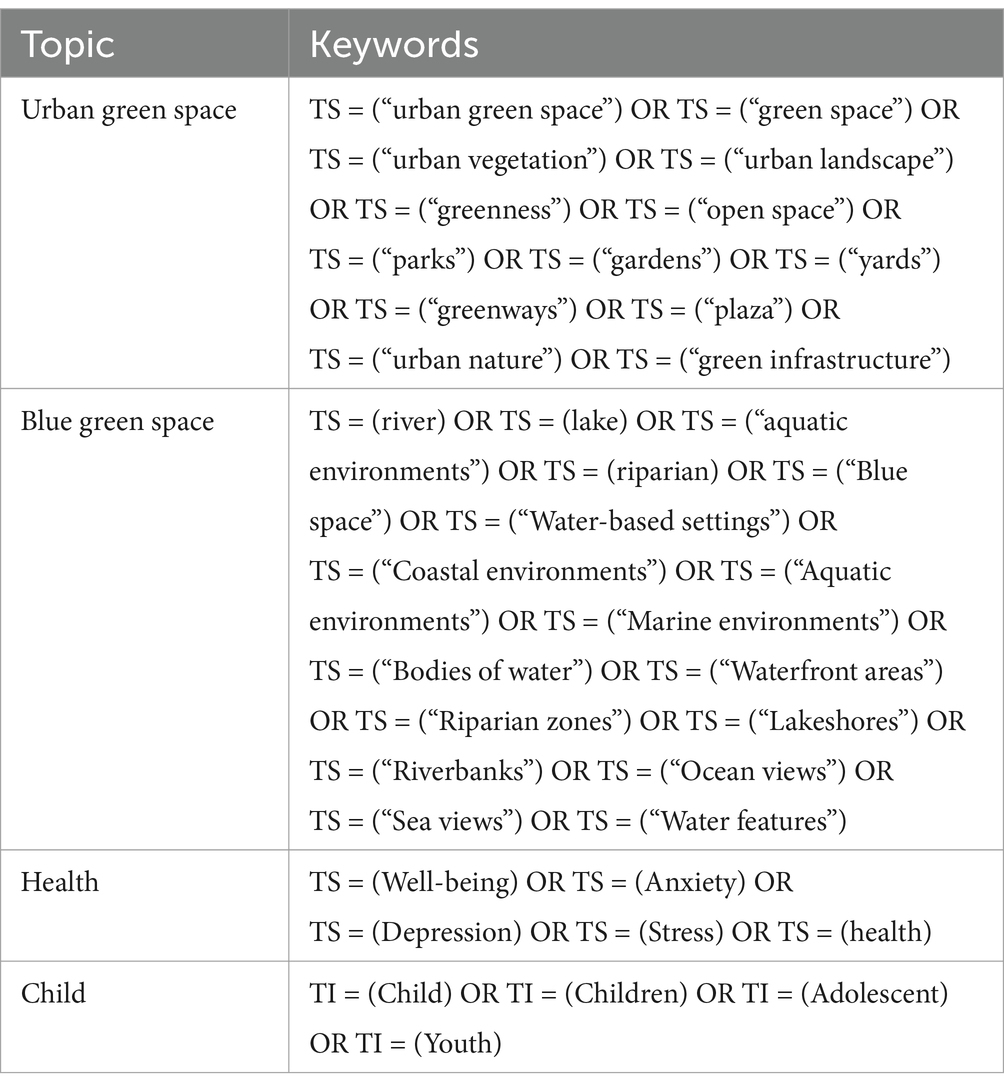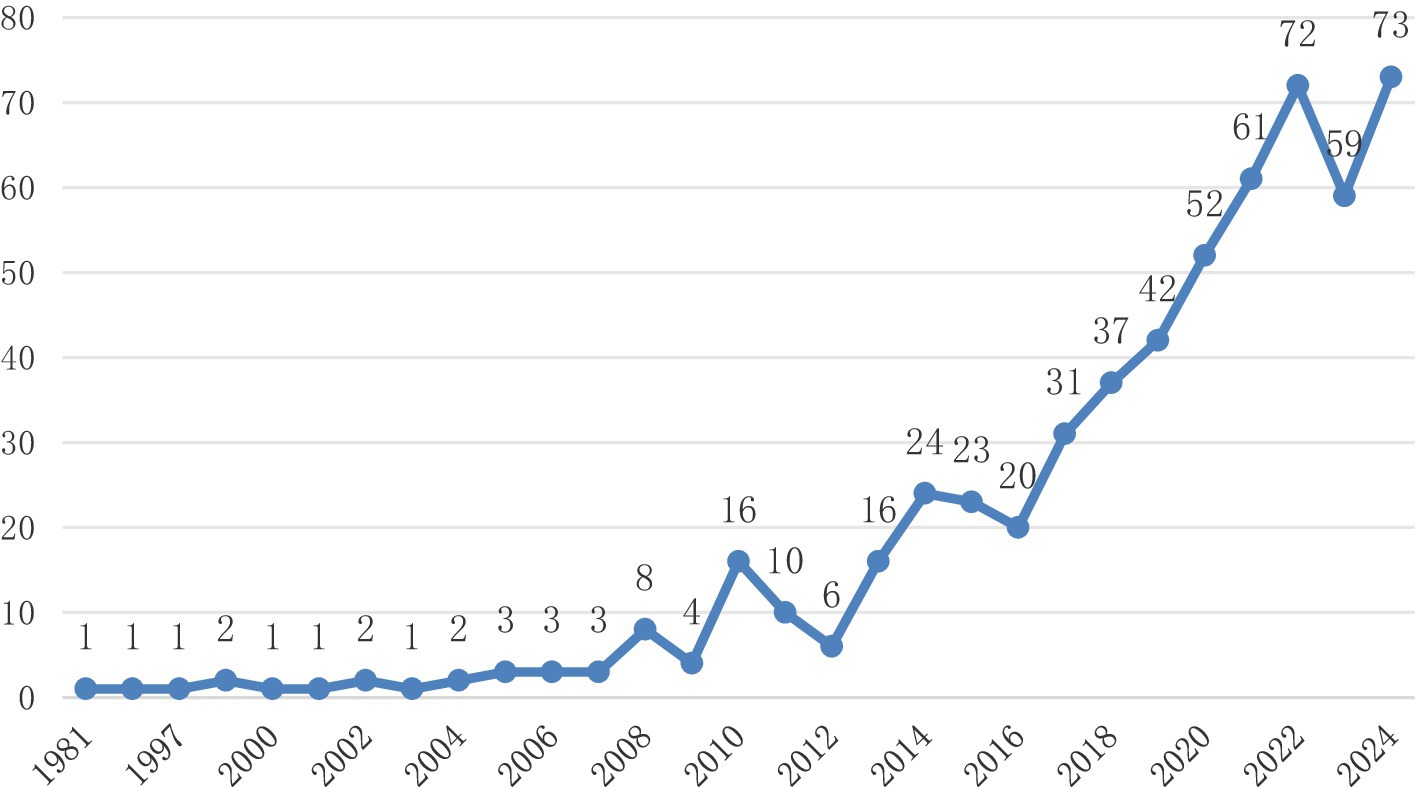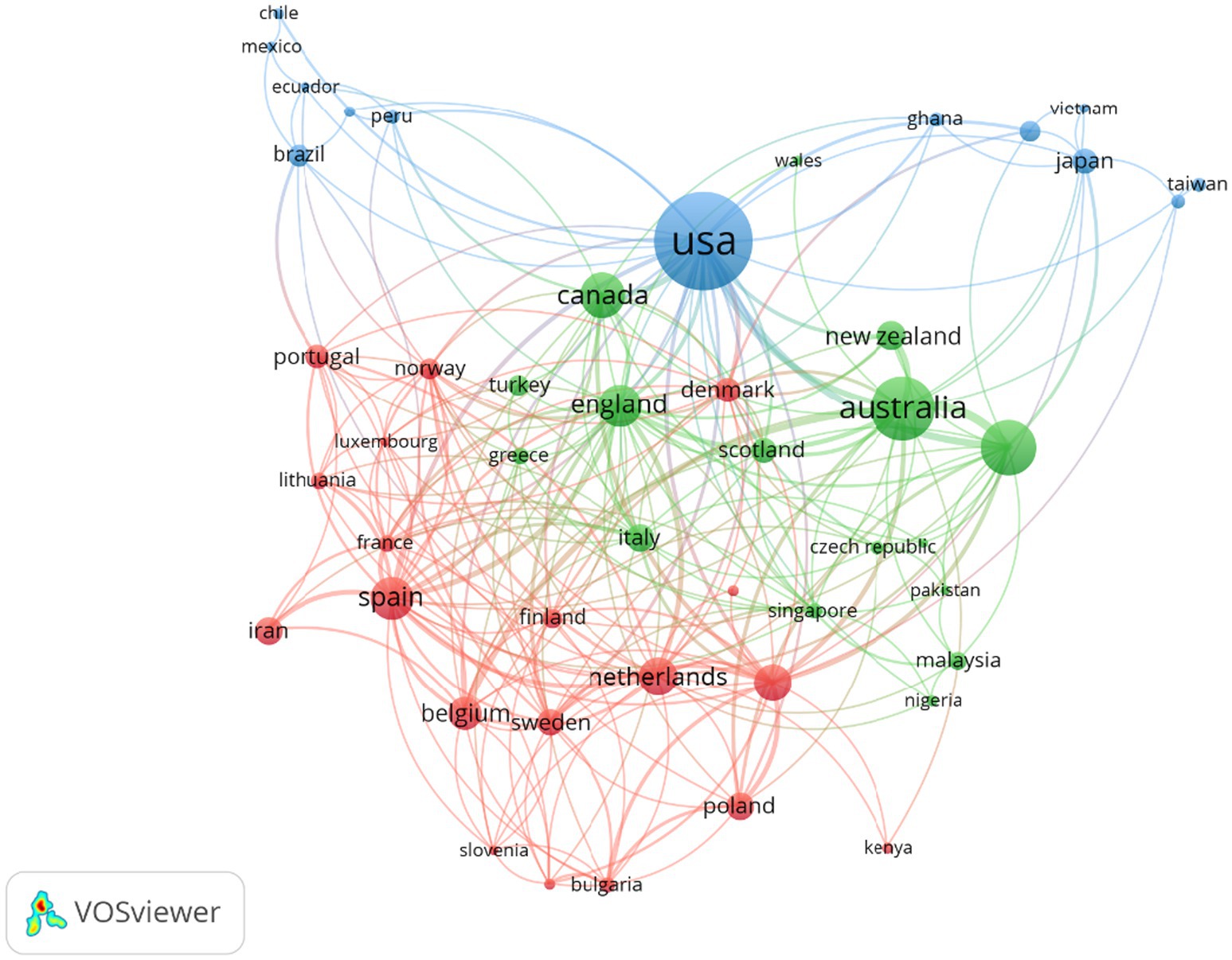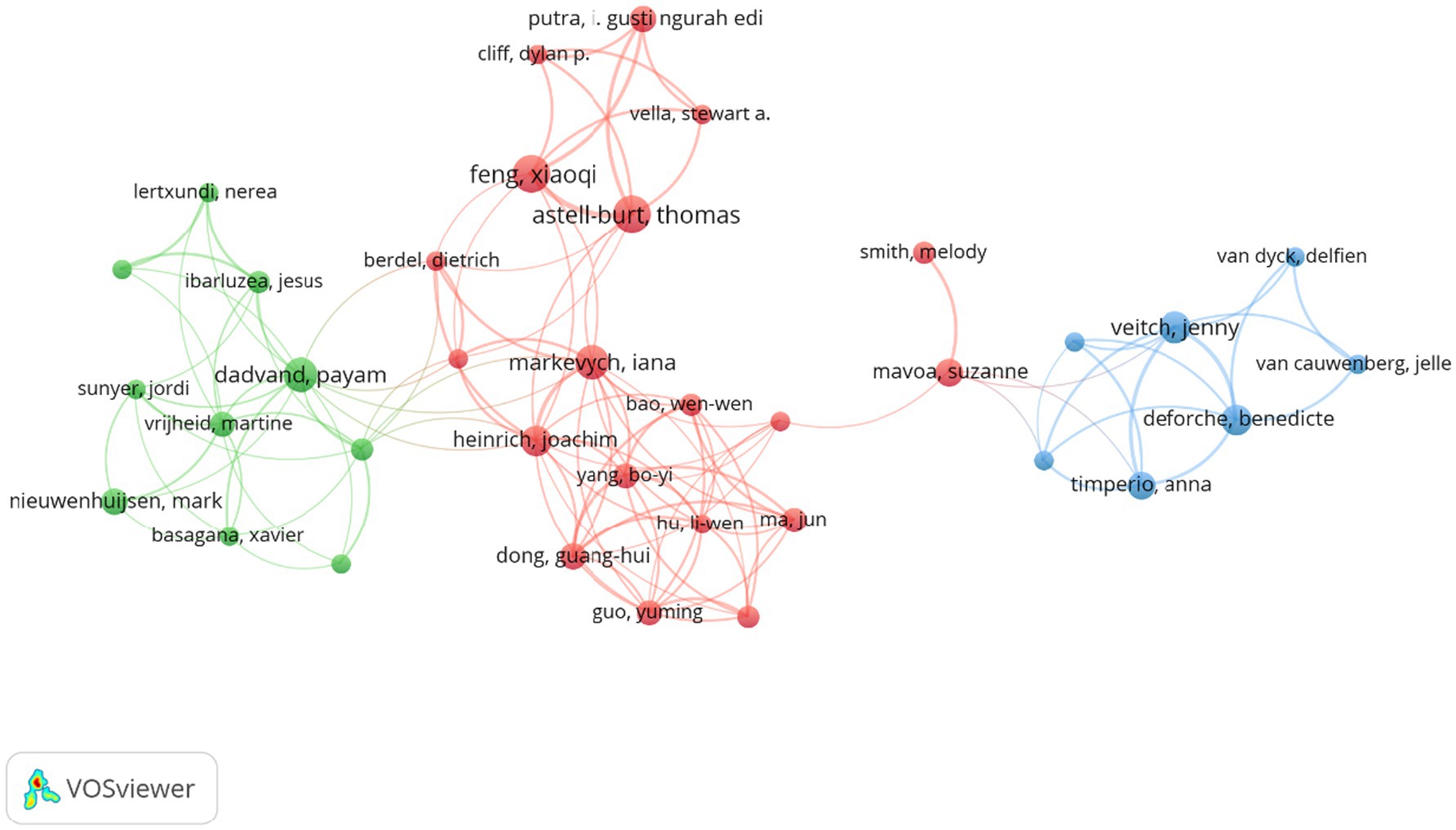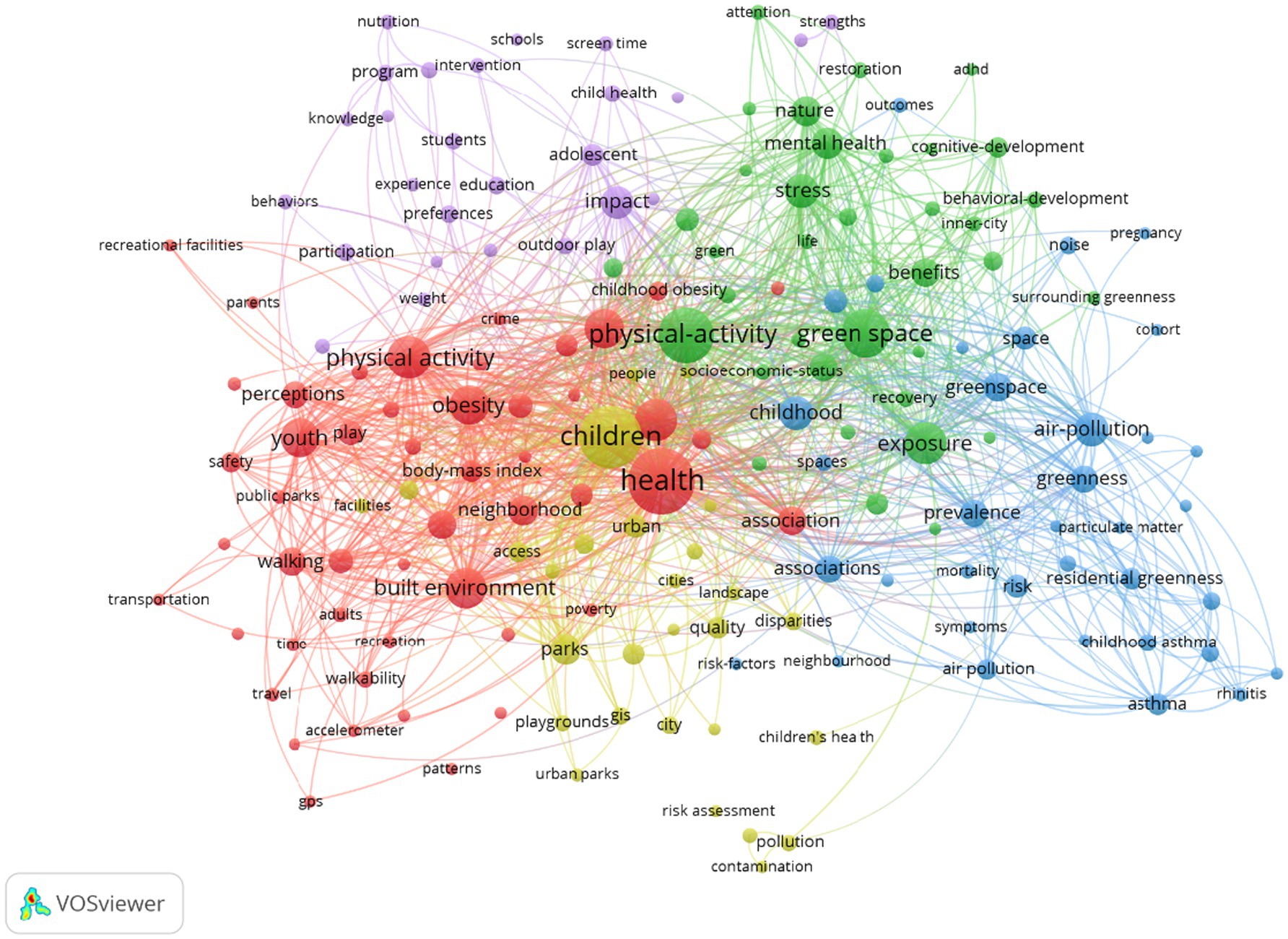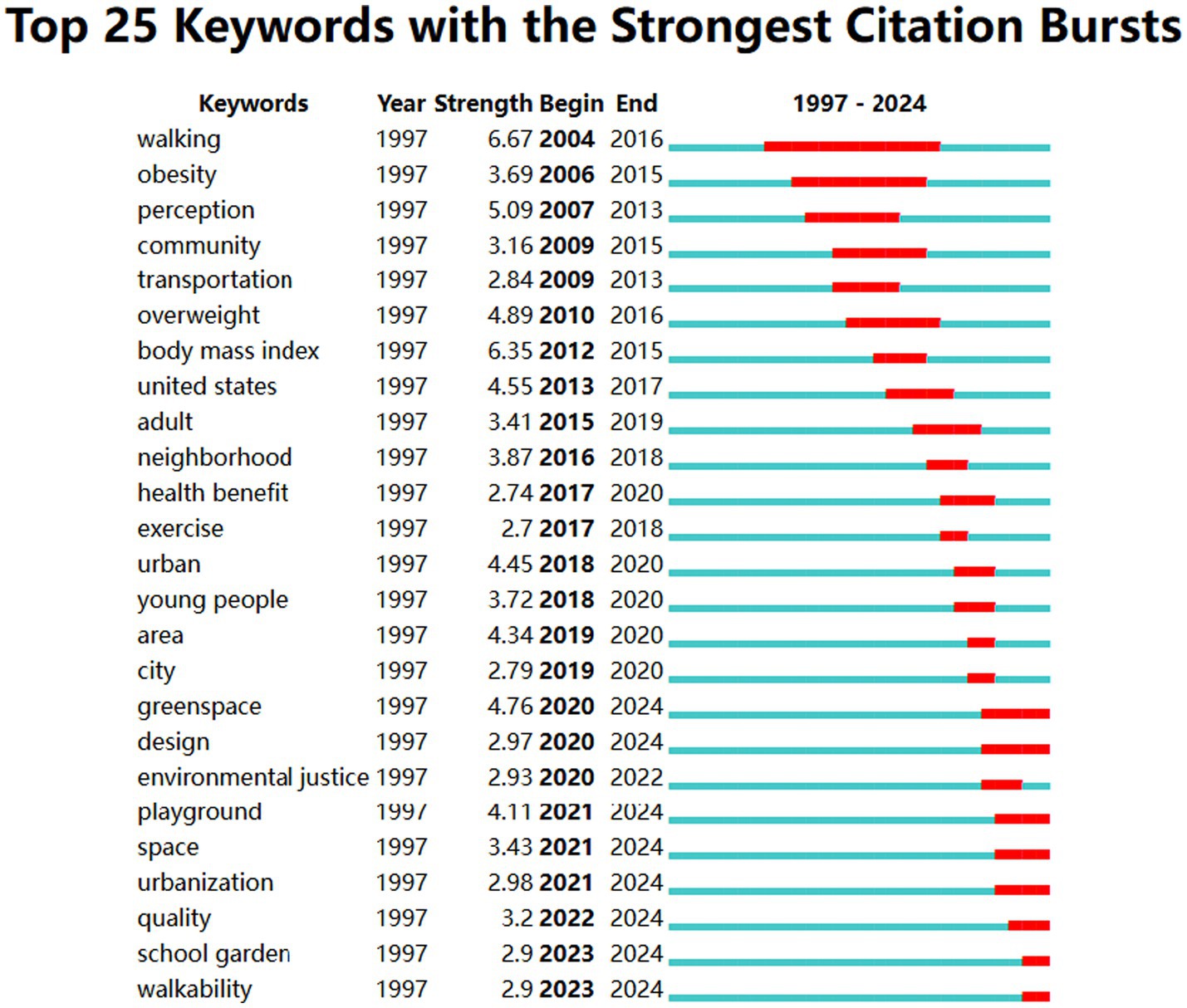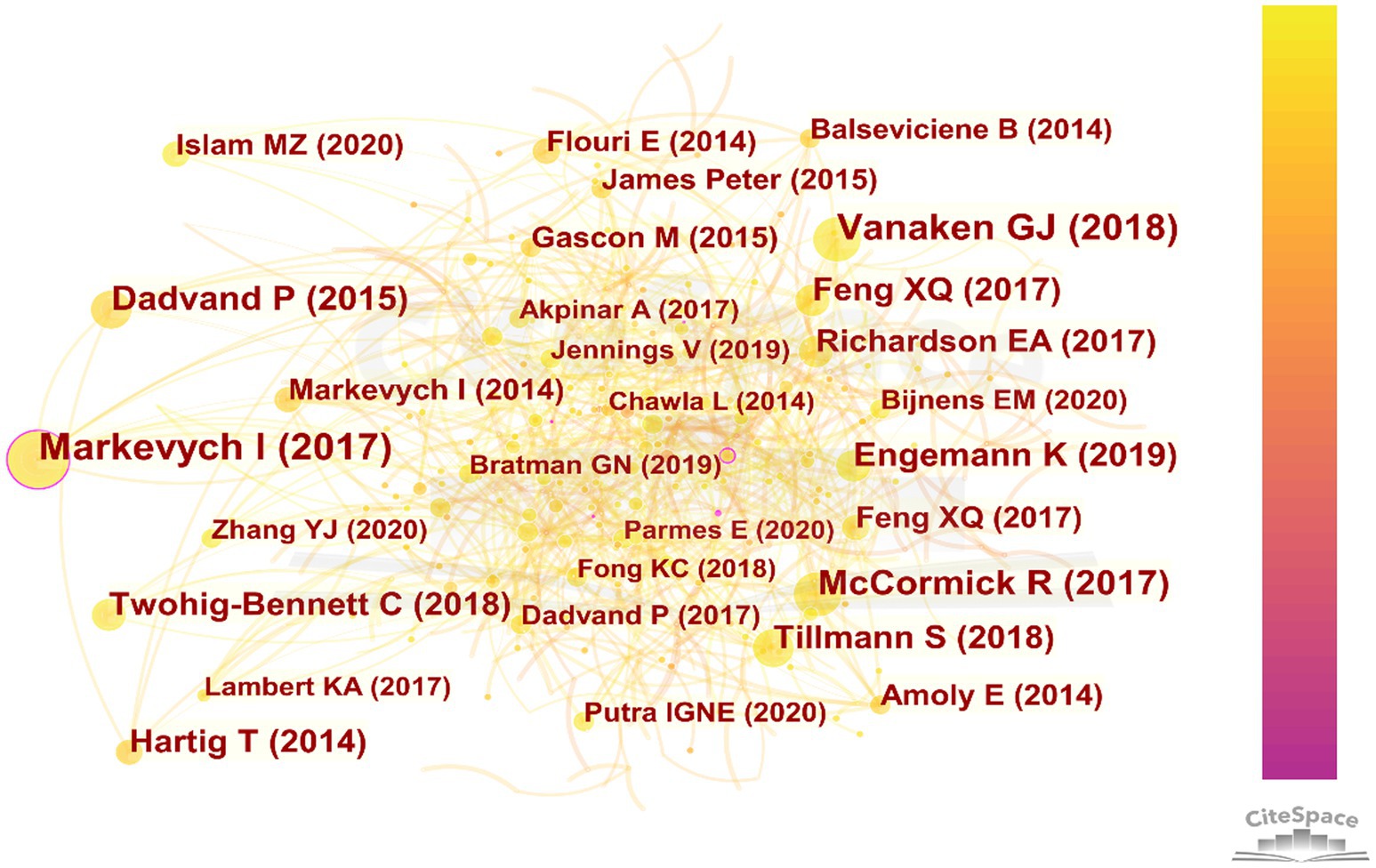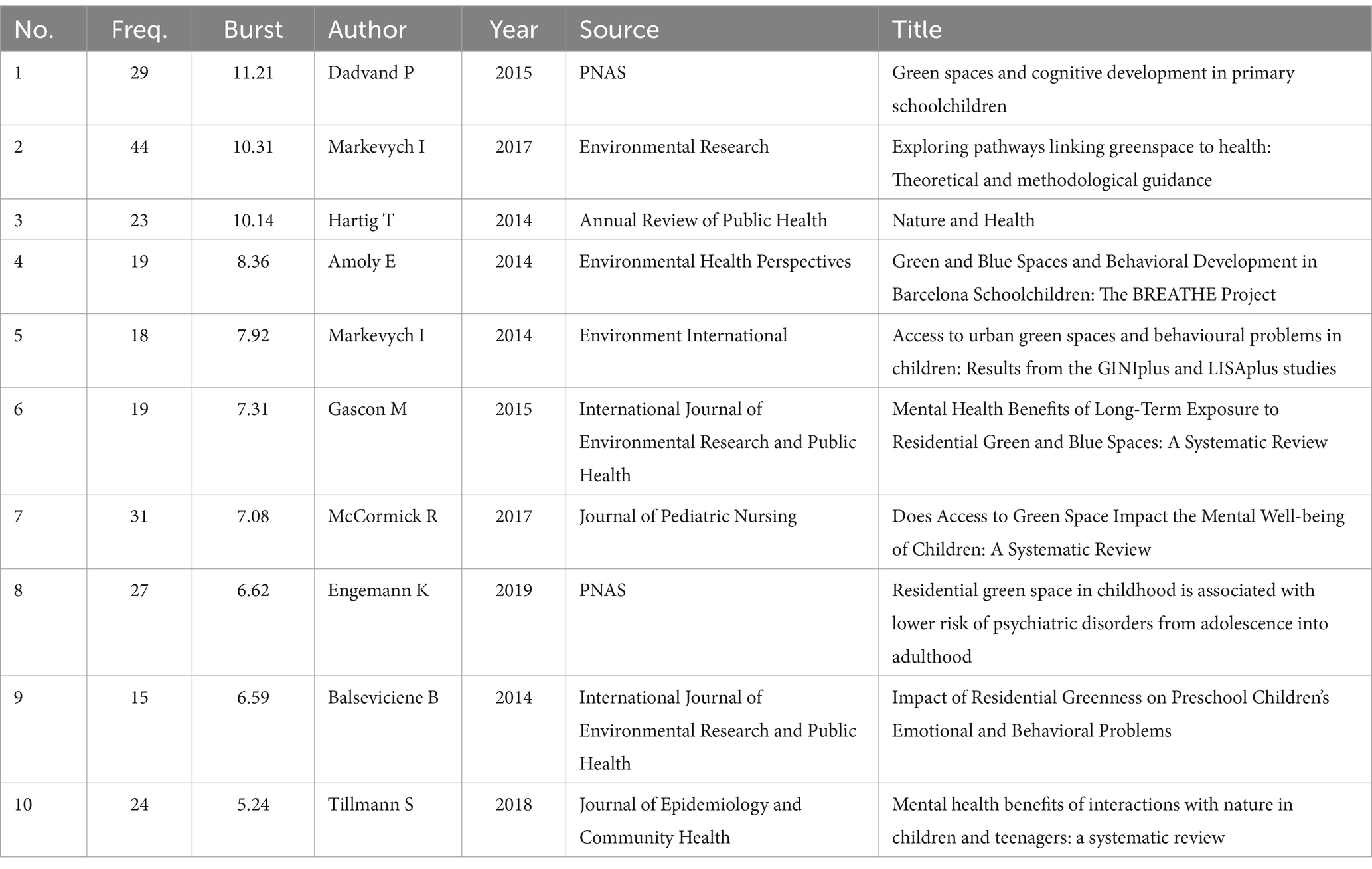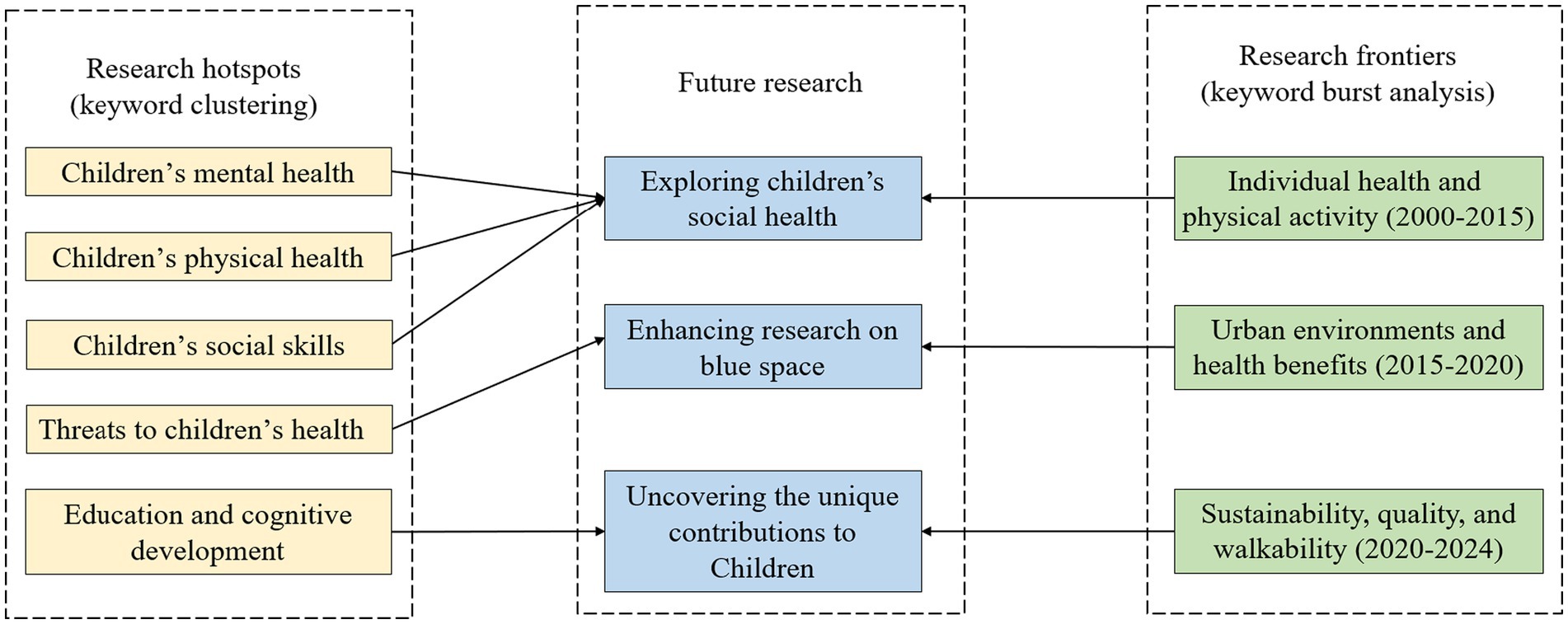- 1Xi'an Innovation College of Yan'an University, Xi'an, China
- 2School of Public Policy and Administration, Xi’an Jiaotong University, Xi'an, China
Introduction: Rapid urbanization has increasingly restricted children’s access to natural environments, raising concerns about potential consequences for their physical, mental, and social well-being. Urban green and blue spaces are known to offer significant health benefits, including physical activity promotion, psychological restoration, and social development.
Methods: This study conducted a comprehensive bibliometric analysis to examine the relationship between urban green/blue spaces and children’s health. A total of 575 relevant publications from 1981 to 2024 were retrieved from the Web of Science database. CiteSpace and VOSviewer were used for keyword co-occurrence analysis, co-citation mapping, and burst detection to visualize research trends and thematic evolution.
Results: Three major research phases were identified: (1) early focus on physical health outcomes, (2) a shift toward urban environmental contexts, and (3) emerging emphasis on sustainability, environmental quality, and walkability. While green spaces have been extensively studied, blue spaces remain underrepresented, especially in terms of their synergistic benefits when combined with green spaces. Key research themes include mental and physical health impacts, social skills development, and the educational functions of nature exposure.
Discussion: This study reveals the interdisciplinary and collaborative nature of current research and emphasizes the importance of ensuring equitable access to high-quality natural environments in urban areas. The findings offer practical implications for urban planners and policymakers and establish a research foundation for promoting sustainable urban development that supports children’s health and well-being.
1 Introduction
The unprecedented pace of urbanization has significantly transformed living environments, particularly for children (Aliyu and Amadu, 2017). Urban landscapes, dominated by concrete and asphalt, have limited opportunities for children to connect with nature (Hand et al., 2018), which has raised serious concerns about its impact on their physical and psychological health. Over recent decades, the importance of nature exposure during childhood has been increasingly recognized. Childhood is a formative period that plays a critical role in emotional, cognitive, and social development. Studies highlight that limited opportunities for exposure to natural environments contribute to higher levels of stress, anxiety, and depression in children (Liu and Green, 2023).
Green and blue spaces, encompassing parks, gardens, rivers, lakes, and coastal areas, have emerged as valuable urban resources for promoting public health. Their benefits for children include facilitating physical activity, fostering social interactions, and enhancing psychological well-being through exposure to restorative environments (Wray et al., 2020; Hernández-Torrano et al., 2020). These spaces not only reduce environmental stressors, such as noise and air pollution, but also serve as catalysts for creativity, exploration, and play. These activities are critical for childhood development. As cities continue to expand, ensuring equitable access to such spaces has become a pressing concern for policymakers and urban planners (Zong et al., 2024).
The potential of green and blue spaces to mitigate urban living’s adverse effects has been widely acknowledged, but the evidence regarding their specific benefits for children remains fragmented. While studies on adults have consistently shown associations between access to natural spaces and reduced stress levels, improved mood, and enhanced cognitive performance (Chan et al., 2023), research on children is often underrepresented or methodologically inconsistent. Most studies are cross-sectional in design, limiting the ability to draw causal inferences, and focus primarily on green spaces near residences, overlooking the importance of school environments and community spaces.
Moreover, blue spaces, such as lakes and rivers, are underexplored compared to green spaces. While green spaces have been widely associated with improved attention, reduced behavioral issues, and enhanced mental well-being in children, the unique contributions of blue spaces remain poorly understood. Additionally, few studies consider the combined effects of green and blue spaces, which might have synergistic benefits for children’s health and development.
The restorative benefits of green and blue spaces can be understood through environmental psychology theories, particularly the Stress Recovery Theory (SRT; Ulrich et al., 1991) and the Attention Restoration Theory (ART; Tennessen and Cimprich, 1995). SRT posits that natural environments promote physiological recovery from stress by reducing blood pressure and enhancing emotional well-being. ART, on the other hand, highlights nature’s role in restoring depleted attention resources, allowing individuals to recover from mental fatigue and regain focus. For children, these theories are particularly relevant, as their developmental stages involve heightened sensitivity to stressors and a greater need for attentional restoration through engaging, yet calming, environments. Our study conducts a comprehensive and systematic bibliometric analysis using CiteSpace and VOSviewer. It focuses on the impact of urban green and blue spaces on children’s health. The analysis examines the current state, trends, and hotspots of research from 1981 to 2024. The objectives of our study are as follows: (1) to provide an overview of the field from the perspectives of time, journals, research areas, international collaborations, and author networks; (2) to reveal the current state and research hotspots of the field through keyword clustering analysis; (3) to explore research frontiers based on keyword burst analysis; (4) to discuss milestone studies in the field through co-citation analysis. The findings of our study offer researchers and policymakers an accurate and systematic description of the literature on the impact of urban green and blue spaces on children’s health. These insights aim to support sustainable urban development and promote children’s health and well-being. By understanding these trends, new scholars and researchers can identify future research directions and questions through interdisciplinary collaboration.
2 Materials and methods
2.1 Data sources
The data for the bibliometric analysis was sourced from the Web of Science (WOS) Core Collection, a comprehensive and widely recognized database for high-quality academic research. WOS Core Collection was chosen for its extensive coverage of peer-reviewed journals across various disciplines, including environmental science, public health, and urban studies, which are central to our study. It offers reliable citation data and advanced search functionalities, enabling precise retrieval of relevant publications. Furthermore, WOS ensures the inclusion of only high-impact and rigorously reviewed content, making it an ideal resource for conducting bibliometric studies that require robust and credible data.
In our study, the search keywords were “urban green space,” “urban blue space,” “health,” and “children” with the specific search keywords detailed in Table 1. The search was restricted to articles and reviews written in English, and the search period extended up to November 4, 2024. A total of 1,219 search results were initially retrieved. After reviewing the titles, abstracts, and keywords, documents that merely mentioned urban green space and children’s health as a contextual background, without specifically addressing the impacts of urban blue and green spaces on children’s health in the results section, were excluded. When necessary, full texts were reviewed to confirm the inclusion criteria. Consequently, irrelevant articles lacking direct relevance to the research objective were removed, resulting in a final dataset of 575 documents selected for subsequent analysis. This selection approach ensured that the included articles provided empirical or substantial discussion of the relationship between urban blue-green spaces and children’s health outcomes. The selected literature data was exported in “.txt” format for further processing.
2.2 Methodology
Bibliometric analysis is a quantitative research method used to evaluate and analyze academic literature within a specific field, providing insights into research trends, impact, and structure (Kim et al., 2016; Chen, 2006; Chen, 2017). This method is widely applied across disciplines to assess research contributions. In our study, bibliometric analysis is particularly valuable for systematically exploring the intersection of green and blue spaces, health, and children, offering a comprehensive understanding of the research landscape.
In our study, bibliometric analysis was conducted using two widely recognized software, CiteSpace and VOSviewer, to analyze the data systematically. Each tool was used for specific analytical purposes, leveraging their strengths in bibliometric visualization and analysis.
First, VOSviewer was used for country co-occurrence analysis and author co-occurrence analysis, aiming to explore the structure and dynamics of scientific collaboration networks. Additionally, VOSviewer’s keyword clustering analysis was used to identify research themes and hotspots, enabling a comprehensive understanding of the focal areas within the domain.
Second, CiteSpace was used to explore the evolution of research trends and frontiers. The keyword burst detection in CiteSpace was used to highlight emerging trends and research frontiers. This helped identify the distinct stages of development within the field. Furthermore, the co-citation analysis of references of CiteSpace was used to identify milestone papers that have significantly influenced the development of the field. This analysis provided a historical perspective, highlighting foundational works and key contributions that shaped the research landscape.
3 Results
3.1 Research trend analysis
3.1.1 Annual publication
To gain a comprehensive understanding of the impact of urban blue and green spaces on children’s health, we analyzed and compiled the annual publication trends from 1981 to 2020 (Figure 1).
The publication trend of papers sourced from the Web of Science database, can be divided into three distinct phases. From 1981 to 2010, the Emerging Phase, the annual number of publications remained minimal, with only 1–3 papers per year, reflecting the infancy of the topic and limited academic attention. Between 2011 and 2015, the Growth Phase, there was a gradual increase in publications, with annual numbers rising to 6–16, indicating an initial recognition of the importance of this research area. From 2016 to 2024, the Rapid Expansion Phase, the field experienced exponential growth, with annual publications surging from 20 in 2016 to 73 in 2024. Notable milestones include a sharp rise from 31 in 2018 to 61 in 2020, and a peak of 73 publications in 2024. This trend highlights the evolution of the field from an underexplored topic to a rapidly expanding research focus.
3.1.2 Journal distribution
The Table 2 identifies the journals publishing articles on the impact of urban blue and green spaces on children’s health. The International Journal of Environmental Research and Public Health leads with 57 publications, followed by Environmental Research with 35. Health & Place ranks third with 22 publications. Journals such as Preventive Medicine (18 articles) and Urban Forestry & Urban Greening (17 articles) focus on proactive health measures and the role of urban greenery. Other notable contributors include Environment International and Landscape and Urban Planning, each with 16 articles, highlighting environmental health and sustainable urban design. This distribution underscores the interdisciplinary appeal of the topic, bridging public health, urban planning, and environmental cience.
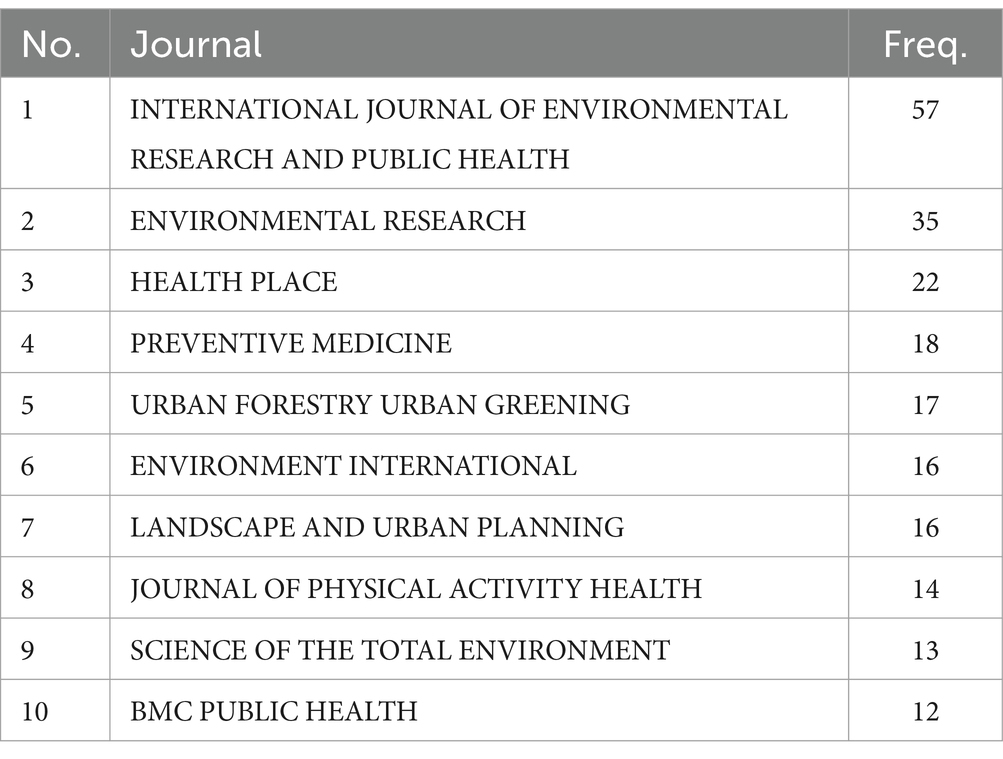
Table 2. The top 10 journals in number of publications on urban green and blue spaces with children’ health.
3.1.3 Research field distribution
The research on urban blue and green spaces and their impact on health spans multiple disciplines, reflecting its interdisciplinary nature (Table 3). Leading the field is Public Environmental Occupational Health, with 268 publications, followed closely by Environmental Sciences Ecology (253), emphasizing health and ecological dimensions. Other key directions include Urban Studies (46) and Geography (36), which explore spatial and urban planning aspects, and General Internal Medicine (34) and Pediatrics (25), focusing on clinical and child health impacts. Behavioral and social sciences, such as Psychology (32) and Public Administration (26), address mental health and policy implications, while interdisciplinary fields like Science and Technology (23) and Nutrition and Dietetics (22) link environmental influences to broader lifestyle factors. Together, these research directions align with the focus of top publishing journals, highlighting the integration of health, environmental sciences, and social sciences in studying the benefits of urban blue and green spaces.

Table 3. The top 10 research areas in number of publications on urban green and blue spaces with children’ health.
3.2 Analysis of research cooperation network
3.2.1 Analysis of cooperation between countries
The distribution (Table 4) of research on urban blue and green spaces reveals significant global participation, with the United States leading in publication frequency (200), followed by Australia (90), China (66), Canada (44), and England (40). Figure 2 presents the cooperation of countries contributing to research on the impact of urban blue and green spaces on children’s health. In this visualization, each node represents a country, and node size indicates the volume of publications from that country. Lines connecting nodes illustrate collaboration between countries, with thicker lines indicating stronger collaborative ties. Different colors distinguish academic clusters or communities that frequently collaborate. The blue cluster is centered on the United States, representing strong transcontinental collaborations, particularly with East Asia countries. The green cluster, led by Australia and New Zealand, highlights regional collaboration within Oceania and connections to Asian countries like Singapore. The red cluster, comprising Spain, Belgium, and the Netherlands, emphasizes close cooperation within Western Europe. These clusters illustrate the global and interconnected nature of this research field, with the USA, Australia, and European countries serving as key hubs of academic activity.
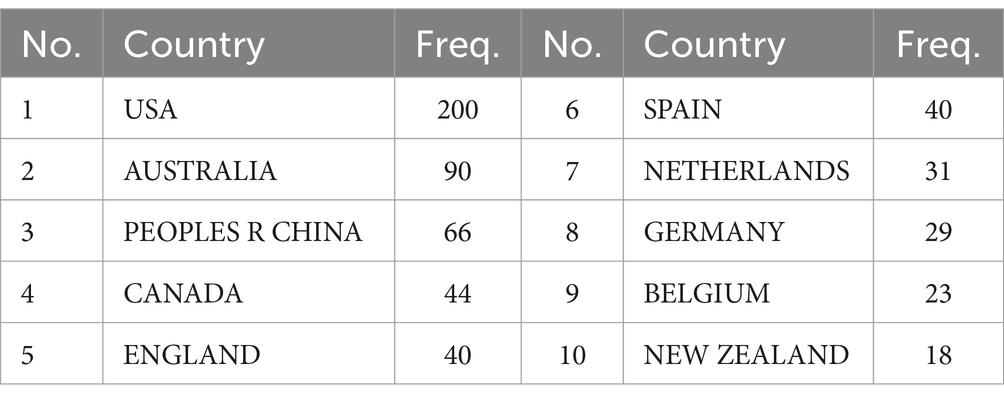
Table 4. The top 10 countries in number of publications on urban green and blue spaces with children’ health.
3.2.2 Analysis of cooperation between authors
The distribution of authors contributing to research on urban blue and green spaces highlights several key contributors (Table 5). Feng Xiaoqi and Astell-Burt Thomas lead with 15 publications each, followed by Markevych Iana (11), Veitch Jenny, and Dadvand Payam (10 each). Other notable contributors include Deforche Benedicte, Heinrich Joachim, and Timperio Anna (9 each). Figure 3 presents a cooperation map of authors. Each node corresponds to an author, with larger nodes representing authors with higher publication counts. The connecting lines between authors indicate co-authorship relationships, where thicker lines reflect stronger collaboration intensity. Three distinct clusters emerge, each highlighted by a different color, representing separate academic communities or research groups. The red cluster, led by Feng Xiaoqi and Astell-Burt Thomas, focuses on physical health and urban environments. The green cluster, including Dadvand Payam, emphasizes behavioral problems in children and greenspace. The blue cluster, led by Veitch Jenny and Deforche Benedicte, centers on children’s use of urban green space.

Table 5. The top 10 authors in number of publications on urban green and blue spaces with children’ health.
3.3 Analysis of research hotspots
Figure 4 is the keyword clustering analysis network in the field of research on urban blue and green spaces and children’s health. Each node represents a keyword, and the size of the node reflects the frequency of that keyword’s appearance across the literature. Links between nodes indicate co-occurrence relationships, with thicker links representing stronger associations. Different colors indicate distinct thematic clusters, revealing the main research themes in this field. The primary keywords within each thematic cluster are presented in Table 6. Five distinct clusters encapsulate the multifaceted impact of urban blue and green spaces on children’s health. The blue cluster highlights the threats posed by blue and green spaces to children’s health, while the yellow cluster focuses on the role of blue and green spaces in influencing children’s education and cognitive development. The purple cluster emphasizes the impact of blue and green spaces on children’s social skills, and the green cluster explores their influence on children’s mental health. Lastly, the red cluster centers on the relationship between blue and green spaces and children’s physical health.
3.3.1 Threats to children’s health from blue and green spaces
Urban blue and green spaces are often hailed as vital components for promoting public health, particularly for vulnerable groups such as children. However, evidence suggests that these spaces may inadvertently become sources of significant health threats due to environmental contamination. For instance, pollutants such as heavy metals and pesticides, commonly found in water sources within urban green spaces, pose serious health risks (Alves et al., 2019). Studies have demonstrated that heavy metals like arsenic, cadmium, and chromium in Tunisian water bodies (Troudi et al., 2022) and pesticide residues in the aquifers of Mexico’s Yucatan Peninsula significantly elevate the risk of carcinogenic among children (Perera-Rios et al., 2022). These findings highlight the dual nature of urban blue and green spaces, which, while theoretically beneficial, may exacerbate health inequities when pollution persists.
Moreover, urban soils and recreational areas within green spaces often serve as reservoirs for hazardous substances, further complicating their threat in public health. Elevated lead concentrations in soils, as observed in Brooklyn, New York, and Seoul, South Korea, not only contribute to heightened blood lead levels in children but also increase their susceptibility to neurodevelopmental impairments and behavioral disorders (Byers et al., 2020). The presence of polycyclic aromatic hydrocarbons (PAHs) in playgrounds and recycled rubber surfaces further exacerbates cancer risks, raising concerns about the safety of these widely used recreational environments (Tarafdar et al., 2020). Such risks are magnified in socioeconomically disadvantaged communities, where children are more likely to encounter these exposures due to systemic inequalities in urban planning and environmental regulation (Pavilonis et al., 2022).
3.3.2 The role of blue and green spaces in education and cognitive development
Urban blue and green spaces play a vital role in fostering children’s cognitive and education. Research demonstrates that early exposure to green spaces is strongly associated with enhanced cognitive functions, including improved attention, working memory, and psychomotor skills, as well as better socioemotional outcomes (Mygind et al., 2021). School gardens further stimulate curiosity, autonomy, and a deeper connection with nature, fostering long-term environmental engagement (Murray et al., 2023). However, access to these benefits is often constrained by socioeconomic inequalities, uneven distribution of green spaces, and parental concerns about safety and environmental quality (Robinson et al., 2022). Additionally, urbanization and increased screen time have exacerbated children’s disconnect from nature, reducing opportunities for exploration and developmental enrichment. To maximize the developmental potential of blue and green spaces, urban planning must prioritize safety, inclusivity, and ecological diversity, while incorporating innovative educational programs that reconnect children with nature, ultimately supporting their holistic growth.
3.3.3 Impact of blue and green spaces on children’s social skills
Urban blue and green spaces play a crucial role in fostering children’s social skills by promoting interaction, collaboration, and a sense of community. Time spent in these spaces allows for unstructured play, which has been shown to enhance cooperation, communication, and trust among peers. For instance, research from Iceland highlights that children who spend more time outdoors report stronger friendships and better social integration (Thorsteinsson et al., 2023). Moreover, natural settings can mitigate the effects of social exclusion by fostering inclusivity and enhancing prosocial behaviors such as empathy and collaboration, particularly in children who have experienced rejection or peer isolation (Chen et al., 2023). Nature-based educational programs and outdoor activities, such as school gardens, further encourage teamwork and shared responsibilities, helping children develop leadership skills and improve group cohesion (Mann et al., 2022). However, challenges such as socioeconomic disparities can limit access to high-quality green spaces, restricting opportunities for social interaction and play, especially for children from disadvantaged backgrounds. Additionally, overly regulated or commercialized green spaces may constrain children’s ability to engage freely, reducing the potential for creative and spontaneous social interactions. Strategies such as integrating green spaces into school curriculums, encouraging community-led maintenance, and creating child-friendly environments can enhance their social utility (Perez-Silva et al., 2023).
3.3.4 Influence of blue and green spaces on children’s mental health
Urban blue and green spaces play a significant role in influencing children’s mental health, offering benefits that enhance happiness and well-being while also mitigating stress and symptoms of depression (Li et al., 2025). Research highlights that exposure to green spaces improves emotional regulation, reduces behavioral difficulties, and promotes prosocial behaviors among children (Caryl et al., 2024). These spaces act as restorative environments, providing opportunities for relaxation, stress relief, and emotional recovery through both passive and active interactions with nature (Zhou et al., 2024). Green spaces near schools have been shown to reduce depressive symptoms in adolescents, especially when combined with limited recreational screen time (Liu et al., 2024). Additionally, coastal environments uniquely contribute to mental health by fostering a sense of curiosity and wonder, promoting emotional resilience and joy (Cabana et al., 2024). On the other hand, the absence or degradation of these natural environments can exacerbate negative mental health outcomes. Awareness of environmental crises, such as climate change and biodiversity loss, may lead to feelings of anxiety, grief, or helplessness, particularly among children learning about these issues in educational settings. However, these emotional responses can often be mitigated by incorporating actionable solutions and collaborative experiences that emphasize positive engagement with nature.
3.3.5 The relationship between blue and green spaces and children’s physical health
Urban blue and green spaces play a crucial role in promoting children’s physical health by encouraging higher levels of physical activity, supporting weight management, and fostering healthy lifestyle habits (Vidal and Castro Seixas, 2022; Russo et al., 2024). Access to well-maintained parks and playgrounds has been consistently linked to increased physical activity, both of which are critical for reducing sedentary behavior and improving overall fitness (Molina-García et al., 2021). Additionally, children living in areas with higher greenness, as measured by Normalized Difference Vegetation Index (NDVI), are less likely to experience obesity due to greater opportunities for outdoor activities and reduced screen time (Bellisario et al., 2022). Blue spaces, such as rivers and coastal areas, further contribute to physical health by offering diverse activity options (Crooks et al., 2022). However, the quality and accessibility of these spaces, including cleanliness, safety, and the presence of recreational facilities, significantly influence their usage and benefits (Jiang et al., 2023). Urbanized areas often face challenges such as limited green space availability, which can reduce physical activity levels and increase obesity risk.
3.4 Analysis of research frontiers
The keyword burst analysis reveals that the research field on the impact of urban blue and green spaces on children’s health can be divided into three distinct phases (Figure 5). The early phase (2000–2015) focused primarily on individual health and physical activity. The transition phase (2015–2020) saw an expansion toward exploring the broader relationship between urban environments and health benefits. Finally, the recent phase (2020–2024) shifted attention to sustainability, quality, and walkability.
During the early phase (2005–2015), the primary focus was on individual health outcomes, particularly related to physical activity and weight management. Keywords such as “walking,” “obesity,” “body mass index,” “perception,” “community,” and “transportation” were prominent. These studies explored how urban spaces influenced physical health indicators like obesity (Martenies et al., 2024) and physical activity (Huang et al., 2024), emphasizing the role of urban design and transportation in promoting healthy behaviors. This phase laid the foundation for understanding the connection between urban environments and health outcomes, with a stronger emphasis on physical rather than mental health.
From 2015 to 2020, the research shifted from individual health to a broader exploration of the urban environment’s impact on health. Keywords such as “health benefit,” “exercise,” “urban,” “neighborhood,” and “area” became significant. This phase marked the beginning of an interest in the interplay between urban neighborhoods, green spaces, and health outcomes. Researchers began to explore the specific mechanisms (Asah et al., 2017) through which urban environments influence health, such as access to exercise opportunities (Klomsten Andersen et al., 2024) and neighborhood design (Bao et al., 2023). Mental health benefits began to emerge as a critical focus during this period.
The most recent phase (2020–2024) demonstrates a significant shift toward sustainability, quality, and walkability. Keywords such as “greenspace,” “design,” “environmental justice,” “playground,” “urbanization,” “quality,” and “walkability” highlight an emphasis on equitable access to urban green spaces (Liao and Furuya, 2024), sustainable urbanization, and the psychological impacts of specific urban interventions. Notably, terms like “school garden” (Kwok et al., 2021) and “playground” (Molina-García et al., 2021) suggest a growing interest in how specific environments, such as schools and pedestrian-friendly spaces, can promote mental health and well-being among children (Din et al., 2023).
3.5 Co-citation analysis of references
Figure 6 shows the visualization of the co-citation network of references. The 10 papers in Table 7, published between 2014 and 2019, reflect the growing and evolving interest in the relationship between urban blue and green spaces and children’s health. Most were published during 2014–2015 (6 out of 10), marking a surge in foundational research, while later publications (2017–2019) shifted toward broader theoretical frameworks, systematic reviews, and longitudinal studies. These papers were published in a variety of high-impact and specialized journals, including PNAS, Environmental Research, Environment International, and the International Journal of Environmental Research and Public Health, highlighting the interdisciplinary nature of the field. Overall, the earlier studies focused on specific relationships, such as cognitive development and behavior, while recent works provide comprehensive evidence and methodological insights, advancing the field toward more systematic and policy-relevant research. Among them, three notable studies specifically examine how these spaces influence children’s behavior. These studies shed light on a critical yet underexplored dimension of this research field, providing valuable insights into the behavioral benefits of blue and green spaces.
Urban blue and green spaces significantly influence children’s behavior and mental health through multiple mechanisms, as revealed by three complementary studies. Regular exposure to green and blue spaces, such as parks and beaches, has been shown to reduce stress, improve attention, and decrease behavioral issues. Increased interaction with green and blue spaces correlated with reductions in emotional problems, peer relationship issues, and ADHD symptoms (Amoly et al., 2014). Similarly, research in Munich found that children living more than 500 meters from urban green spaces had a higher risk of hyperactivity and attention problems, with boys particularly affected, highlighting the importance of proximity (Markevych et al., 2014). In Lithuania, while higher residential greenness benefited children from lower-education households, it was paradoxically associated with increased behavioral problems among children from higher-education households (Balseviciene et al., 2014).
These effects are mediated by mechanisms such as psychological restoration, enhanced physical activity, reduced exposure to pollution and noise, and opportunities for social interaction. Immediate green space proximity (e.g., within 100 or 300 meters) has been associated with direct psychological benefits like stress reduction, while larger green spaces tend to support physical activity and social behaviors. Collectively, these findings emphasize the need for equitable access to well-maintained blue and green spaces in urban areas to foster children’s healthy behavioral and psychological development.
4 Discussion
Based on the results of keyword clustering and keyword burst analysis (as shown in Figure 7), this study suggests three major directions for future research. These directions not only reflect the evolving focus of existing literature but also point toward emerging gaps that warrant further exploration. First, future studies should prioritize enhancing the role of blue spaces in urban research, recognizing their potential health and developmental benefits for children. Second, more attention should be paid to exploring the social health impacts of both blue and green spaces on children. Third, it is essential to uncover the unique contributions of blue and green spaces to children.
4.1 Enhancing the blue spaces in urban research
Emphasis on blue spaces is crucial for understanding the relationship between urban environments and children’s health. While much of the existing research has focused predominantly on the health benefits of green spaces, the unique contributions of blue spaces, such as rivers, lakes, and oceans, remain underexplored (Rouse and Wishart, 2024). Unlike green spaces, blue spaces offer unique, water-related opportunities that substantially differ in their mechanisms and magnitude of health impact. Specifically, blue spaces provide exclusive opportunities for water-based physical activities like swimming, boating, kayaking, and other forms of aquatic recreation, which are generally unavailable in typical green parks or urban gardens (White et al., 2020). These activities not only promote physical fitness but also encourage skill development among children (Foley and Kistemann, 2015). Moreover, blue spaces have been shown to offer enhanced psychological benefits distinct from green spaces, such as stronger stress reduction effects due to the calming sensory experience of water, often termed the “blue effect” (Gascon et al., 2017). The rhythmic sounds and visuals associated with water environments can uniquely contribute to relaxation, emotional restoration, and mental well-being in children, potentially more intensively than green spaces alone (Nutsford et al., 2016).
Another unique attribute of blue spaces is their ecological and biodiversity value. These areas typically support diverse aquatic and semiaquatic ecosystems, offering richer biodiversity experiences compared to typical urban green spaces (Völker and Kistemann, 2011). Direct exposure to diverse wildlife and ecosystems can significantly enhance children’s environmental awareness, emotional connections with nature, and educational experiences (Keniger et al., 2013). Moreover, existing research rarely addresses the potential synergistic effects of combined green and blue spaces. Urban areas integrating both types of spaces—such as parks adjacent to lakes or riverside greenways—may amplify health benefits through diversified recreational opportunities, varied sensory experiences, and increased social interactions among children (Bell et al., 2018). Such integrated environments could offer enhanced restorative effects and encourage greater levels of physical and social engagement compared to isolated green or blue spaces (Britton et al., 2020).
4.2 Exploring the social health impacts of blue and green spaces on children
While the relationship between blue and green spaces and children’s physical and mental health has been well-documented (Wu et al., 2021), their impact on children’s social health remains underexplored. Social health, encompassing aspects such as social skills, peer interactions, and a sense of community, is a critical component of overall well-being, particularly during childhood. Urban blue and green spaces can serve as valuable settings for promoting social health by encouraging group activities, fostering social interactions, and providing inclusive environments where children can develop teamwork and communication skills. Research on how blue and green spaces facilitate social interactions is still limited, but the potential benefits are evident. For instance, playgrounds in green spaces or accessible waterfront areas can create opportunities for children to engage in cooperative play, build friendships, and strengthen peer relationships (George et al., 2024). Additionally, well-designed natural spaces can reduce social inequalities by offering inclusive spaces that accommodate children from diverse socioeconomic backgrounds. Future studies should investigate the mechanisms through which blue and green spaces influence social health, considering factors such as design, accessibility, and cultural context.
4.3 Uncovering the unique contributions of blue and green spaces to children
While the physical, mental, and social health benefits of blue and green spaces are widely recognized across all age groups, including children, middle-aged adults, and the elderly, it is essential to explore the unique impacts of these spaces on children. As individuals whose cognitive and emotional capacities are still developing, children experience blue and green spaces differently. These natural environments serve as vital platforms for exploration, learning, and cognitive development, offering opportunities for children to engage with nature, stimulate curiosity, and foster creativity. Blue and green spaces provide children with a unique setting to embrace and perceive nature, contributing significantly to their cognitive and emotional growth. Activities in such environments, such as interacting with plants, observing wildlife, or simply playing in green areas, enhance both intellectual (IQ) and emotional intelligence (EQ). Through these interactions, children not only develop critical thinking but also cultivate empathy, patience, and social awareness. Moreover, as children learn about the ecosystem, plants, and natural processes, their understanding of the environment deepens, fostering a lifelong connection to nature and a sense of responsibility toward preserving it. Future research should focus on the developmental aspects of blue and green spaces for children, investigating how these spaces contribute to specific cognitive milestones and emotional well-being.
4.4 Policy implications
Our study offers several practical implications for policymakers and urban planners seeking to promote children’s health through the provision of green and blue spaces. First, the findings highlight the importance of incorporating a variety of multifunctional natural spaces, including parks, riversides, school gardens, and green schoolyards, into urban planning. These spaces should not only be available but also equitably distributed to ensure that children from all socioeconomic backgrounds can benefit from their physical, mental, and social health advantages. In addition, green and blue spaces should be designed with children’s needs in mind, balancing safety, playability, and ecological richness. By fostering opportunities for unstructured play, physical activity, exploration, and quiet reflection, these environments can promote holistic development. Second, the study highlights the importance of ensuring environmental quality in urban natural spaces. Policymakers should strengthen environmental monitoring and maintenance to address potential threats such as soil contamination, water pollution, and exposure to hazardous materials. Clean, safe, and accessible environments are essential for realizing the full health potential of urban nature. Third, integrating nature-based education and mental health programs into schools and community services can further amplify the benefits of green and blue spaces. Initiatives such as outdoor learning environments, school gardening programs, and nature therapy can foster cognitive development, reduce stress, and cultivate environmental awareness and stewardship from an early age.
5 Conclusion
Our study provides a comprehensive bibliometric analysis of research on the impact of urban blue and green spaces on children’s health. This field demonstrates an interdisciplinary nature, encompassing public health, environmental science, and urban studies. Collaborative networks among countries, authors, and institutions highlight the global and interconnected nature of this research, with the United States, Australia, and European countries acting as key hubs of academic activity. The findings reveal significant growth in academic interest over three distinct phases: an early focus on individual health and physical activity (2000–2015), a transition to broader exploration of urban environments and health benefits (2015–2020), and a recent emphasis on sustainability, quality, and walkability (2020–2024). Keyword clustering analysis further identifies five key research hotspots: physical health benefits, mental health impacts, social skill development, educational and cognitive outcomes, and environmental threats posed by blue and green spaces. While the benefits of green spaces have been extensively studied, blue spaces remain underrepresented despite their potential to contribute uniquely to children’s health. Additionally, we further identify future research trends in the study of urban blue and green spaces and their impact on children’s health. Our study provides a foundational understanding of this field and serves as a reference for future scholars conducting related research.
Data availability statement
The raw data supporting the conclusions of this article will be made available by the authors, without undue reservation.
Author contributions
YK: Conceptualization, Data curation, Funding acquisition, Project administration, Software, Supervision, Writing – review & editing. ZG: Conceptualization, Methodology, Visualization, Writing – original draft.
Funding
The author(s) declare that financial support was received for the research and/or publication of this article. This research was funded by Xi’an Innovation College of Yan’an University 2024 School-Level Research Project titled Research on the Theory and Practice of Integrating Philosophy for Children into Early Childhood Art Education (grant number 2024XJKY13), Xi’an Innovation College of Yan’an University Special Project on Teaching Reform for “Humanoid Robots + Curriculum” titled Construction of a “Human-Robot Dual-Teacher” Model Driven by Humanoid Robot Educational Scenarios — Teaching Reform of Educational Research Methods Course Based on AIGC (grant number 2025YKG02), and 2024 Shaanxi Province Education Science “14th Five-Year Plan” Project titled Research on the Current Status and Enhancement Pathways of Positive Psychological Qualities in Rural Children (grant number SGH24Q502).
Conflict of interest
The authors declare that the research was conducted in the absence of any commercial or financial relationships that could be construed as a potential conflict of interest.
Generative AI statement
The author(s) declare that no Generative AI was used in the creation of this manuscript.
Publisher’s note
All claims expressed in this article are solely those of the authors and do not necessarily represent those of their affiliated organizations, or those of the publisher, the editors and the reviewers. Any product that may be evaluated in this article, or claim that may be made by its manufacturer, is not guaranteed or endorsed by the publisher.
Reference
Aliyu, A. A., and Amadu, L. (2017). Urbanization, cities, and health: the challenges to Nigeria - a review. Ann. Afr. Med. 16, 149–158. doi: 10.4103/aam.aam_1_17
Alves, R. I. S., Machado, G. P., Zagui, G. S., Bandeira, O. A., Santos, D. V., Nadal, M., et al. (2019). Metals risk assessment for children's health in water and particulate matter in a southeastern Brazilian city. Environ. Res. 177:108623. doi: 10.1016/j.envres.2019.108623
Amoly, E., Dadvand, P., Forns, J., López-Vicente, M., Basagaña, X., Julvez, J., et al. (2014). Green and blue spaces and behavioral development in Barcelona schoolchildren: the BREATHE project. Environ. Health Perspect. 122, 1351–1358. doi: 10.1289/ehp.1408215
Asah, S. T., Bengston, D. N., Westphal, L. M., and Gowan, C. H. (2017). Mechanisms of children’s exposure to nature: predicting adulthood environmental citizenship and commitment to nature-based activities. Environ. Behav. 50, 807–836. doi: 10.1177/0013916517718021
Balseviciene, B., Sinkariova, L., Grazuleviciene, R., Andrusaityte, S., Uzdanaviciute, I., Dedele, A., et al. (2014). Impact of residential greenness on preschool children's emotional and behavioral problems. Int. J. Environ. Res. Public Health 11, 6757–6770. doi: 10.3390/ijerph110706757
Bao, Y., Gao, M., Luo, D., and Zhou, X. (2023). Urban parks—a catalyst for activities! The effect of the perceived characteristics of the urban park environment on children’s physical activity levels. Forests 14:423. doi: 10.3390/f14020423
Bell, S. L., Phoenix, C., Lovell, R., and Wheeler, B. W. (2018). Seeking everyday wellbeing: the coast as a therapeutic landscape. Soc. Sci. Med. 142, 56–67. doi: 10.1016/j.socscimed.2015.08.011
Bellisario, V., Comoretto, R. I., Berchialla, P., Koumantakis, E., Squillacioti, G., Borraccino, A., et al. (2022). The association between greenness and urbanization level with weight status among adolescents: new evidence from the HBSC 2018 Italian survey. Int. J. Environ. Res. Public Health 19:5897. doi: 10.3390/ijerph19105897
Britton, E., Kindermann, G., Domegan, C., and Carlin, C. (2020). Blue care: a systematic review of blue space interventions for health and wellbeing. Health Promot. Int. 35, 50–69. doi: 10.1093/heapro/day103
Byers, H. L., McHenry, L. J., and Grundl, T. J. (2020). Increased risk for lead exposure in children through consumption of produce grown in urban soils. Sci. Total Environ. 743:140414. doi: 10.1016/j.scitotenv.2020.140414
Cabana, D., Pinna, S., Farina, S., Grech, D., Barbieri, N., and Guala, I. (2024). Coastal cultural ecosystem services and adolescents' subjective well-being. Ambio 53, 1561–1573. doi: 10.1007/s13280-024-02043-2
Caryl, F., McCrorie, P., Olsen, J. R., and Mitchell, R. (2024). Use of natural environments is associated with reduced inequalities in child mental wellbeing: a cross-sectional analysis using global positioning system (GPS) data. Environ. Int. 190:108847. doi: 10.1016/j.envint.2024.1088
Chan, S. H. M., Qiu, L., Esposito, G., Mai, K. P., Tam, K. P., and Cui, J. (2023). Nature in virtual reality improves mood and reduces stress: evidence from young adults and senior citizens. Virtual Reality 27, 3285–3300. doi: 10.1007/s10055-021-00604-4
Chen, C. (2006). CiteSpace II: detecting and visualizing emerging trends and transient patterns in scientific literature. J. Am. Soc. Inf. Sci. Technol. 57, 359–377. doi: 10.1002/asi.20317
Chen, C. (2017). Science mapping: a systematic review of the literature. J. Data Info. Sci. 2, 1–40. doi: 10.1515/jdis-2017-0006
Chen, L., Zeng, S., and Su, Y. (2023). The influence of social exclusion on adolescents' social withdrawal behavior: the moderating role of connectedness to nature. J. Environ. Psychol. 87:101951. doi: 10.1016/j.jenvp.2022.101951
Crooks, N., Becker, D., Gaskin, C. J., Nichols, M., Bolton, K. A., Orellana, L., et al. (2022). Relationship between "blue space" proximity and children's weight status, health behaviors, and health-related quality of life among a sample of regional Victorian primary school children. Child. Obes. 18, 494–506. doi: 10.1089/chi.2021.0219
Din, S. K.-J., Russo, A., and Liversedge, J. (2023). Designing healing environments: a literature review on the benefits of healing gardens for children in healthcare facilities and the urgent need for policy implementation. Landscape 12:971. doi: 10.3390/land12050971
Foley, R., and Kistemann, T. (2015). Blue space geographies: enabling health in place. Health Place 35, 157–165. doi: 10.1016/j.healthplace.2015.07.003
Gascon, M., Zijlema, W., Vert, C., White, M. P., and Nieuwenhuijsen, M. J. (2017). Outdoor blue spaces, human health and well-being: a systematic review of quantitative studies. Int. J. Hyg. Environ. Health 220, 1207–1221. doi: 10.1016/j.ijheh.2017.08.004
George, P., Murray, K., Trost, S. G., Boruff, B., and Christian, H. (2024). Associations between natural blue and green space and preschool children's movement behaviours. People Nature 6, 1668–1680. doi: 10.1002/pan3.10682
Hand, K. L., Freeman, C., Seddon, P. J., Recio, M. R., Stein, A., and van Heezik, Y. (2018). Restricted home ranges reduce children’s opportunities to connect to nature: demographic, environmental and parental influences. Landsc. Urban Plan. 172, 69–77. doi: 10.1016/j.landurbplan.2017.12.004
Hernández-Torrano, D., Ibrayeva, L., Sparks, J., Lim, N., Clementi, A., Almukhambetova, A., et al. (2020). Mental health and well-being of university students: a bibliometric mapping of the literature. Front. Psychol. 11:1226. doi: 10.3389/fpsyg.2020.01226
Huang, X., Yang, Z., Lin, J., Li, Y., Chen, Y., Shi, F., et al. (2024). A study on the spillover effects of children’s outdoor activity space allocation in high-density urban areas: a case study of Beijing. Buildings 14:2872. doi: 10.3390/buildings14092872
Jiang, Q., Carlson, J. A., Kaczynski, A. T., Shook, R. P., Besenyi, G. M., Steel, C., et al. (2023). Neighborhood park access and park characteristics are associated with weight status in youth. Health Place 83:103116. doi: 10.1016/j.healthplace.2023.103116
Keniger, L. E., Gaston, K. J., Irvine, K. N., and Fuller, R. A. (2013). What are the benefits of interacting with nature? Int. J. Environ. Res. Public Health 10, 913–935. doi: 10.3390/ijerph10030913
Kim, M. C., Zhu, Y., and Chen, C. (2016). How are they different? A quantitative domain comparison of information visualization and data visualization (2000–2014). Science 107, 123–165. doi: 10.1007/s11192-015-1830-0
Klomsten Andersen, O., Gebremariam, M. K., Kaupang, O. B., Lien, N., and Kolle, E. (2024). Built for movement: neighborhoods and adolescent physical activity behaviors, and the moderating role of socioeconomic position and gender. Health Place 89:103313. doi: 10.1016/j.healthplace.2024.103313
Kwok, S. W. H., Wu, C. S. T., Tong, H. T., Ho, C. N., Leung, K. L., Leung, Y. C. P., et al. (2021). Effects of the school-based integrated health promotion program with hydroponic planting on green space use and satisfaction, dietary habits, and mental health in early adolescent students: a feasibility quasi-experiment. Front. Public Health 9:740102. doi: 10.3389/fpubh.2021.740102
Li, Y., Li, W., and Liu, Y. (2025). Remedies from nature: exploring the moderating mechanisms of natural landscape features on emotions and perceived restoration in urban parks. Front. Psychol. 15:1502240. doi: 10.3389/fpsyg.2024.1502240
Liao, Y., and Furuya, K. (2024). A case study on children’s accessibility in urban parks in Changsha City, China: developing an improved 2SFCA method. Landscape 13:1522. doi: 10.3390/land13091522
Liu, J., and Green, R. J. (2023). The effect of exposure to nature on children’s psychological well-being: a systematic review of the literature. Urban For. Urban Green. 81:127846. doi: 10.1016/j.ufug.2023.127846
Liu, Y., Li, S., Deng, T., Li, L., Wei, R., Zhang, Y., et al. (2024). The association between green space around schools, screen time for entertainment, and adolescent depressive symptoms: a nationwide study from China. Environ. Res. 263:120100. doi: 10.1016/j.envres.2024.120100
Mann, J., Gray, T., Truong, S., Brymer, E., Passy, R., Ho, S., et al. (2022). Getting out of the classroom and into nature: a systematic review of nature-specific outdoor learning on school children's learning and development. Front. Public Health 10:877058. doi: 10.3389/fpubh.2022.877058
Markevych, I., Tiesler, C. M., Fuertes, E., Romanos, M., Dadvand, P., Nieuwenhuijsen, M. J., et al. (2014). Access to urban green spaces and behavioural problems in children: results from the GINIplus and LISAplus studies. Environ. Int. 71, 29–35. doi: 10.1016/j.envint.2014.06.002
Martenies, S. E., Oloo, A., Magzamen, S., Ji, N., Khalili, R., Kaur, S., et al. (2024). Independent and joint effects of neighborhood-level environmental and socioeconomic exposures on body mass index in early childhood: the environmental influences on child health outcomes (ECHO) cohort. Environ. Res. 253:119109. doi: 10.1016/j.envres.2024.119109
Molina-García, J., Menescardi, C., Estevan, I., and Queralt, A. (2021). Associations between park and playground availability and proximity and children's physical activity and body mass index: the BEACH study. Int. J. Environ. Res. Public Health 19:250. doi: 10.3390/ijerph19010250
Murray, L., Breheny, M., Cumming, R., Erueti, B., Mooney, M., Nash, K. L., et al. (2023). How does learning about the future of the ocean impact children's emotional wellbeing? Insights from ocean literacy educators in Aotearoa New Zealand. People Nature 5, 1622–1635. doi: 10.1002/pan3.10528
Mygind, L., Kurtzhals, M., Nowell, C., Melby, P. S., Stevenson, M. P., Nieuwenhuijsen, M., et al. (2021). Landscapes of becoming social: a systematic review of evidence for associations and pathways between interactions with nature and socioemotional development in children. Environ. Int. 146:106238. doi: 10.1016/j.envint.2020.106238
Nutsford, D., Pearson, A. L., Kingham, S., and Reitsma, F. (2016). Residential exposure to visible blue space (but not green space) associated with lower psychological distress in a capital city. Health Place 39, 70–78. doi: 10.1016/j.healthplace.2016.03.002
Pavilonis, B., Cheng, Z., Johnson, G., and Maroko, A. (2022). Lead, soils, and children: an ecological analysis of lead contamination in parks and elevated blood lead levels in Brooklyn, New York. Arch. Environ. Contam. Toxicol. 82, 1–10. doi: 10.1007/s00244-021-00902-7
Perera-Rios, J., Ruiz-Suarez, E., Bastidas-Bastidas, P. J., May-Euán, F., Uicab-Pool, G., Leyva-Morales, J. B., et al. (2022). Agricultural pesticide residues in water from a karstic aquifer in Yucatan, Mexico, pose a risk to children's health. Int. J. Environ. Health Res. 32, 2218–2232. doi: 10.1080/09603123.2021.1950652
Perez-Silva, R., Fernández, I. C., Matas, M. I., and Villalobos, E. (2023). Green cover and socioemotional and academic outcomes of school-age children: the case of Santiago, Chile. Landsc. Urban Plan. 233:104688. doi: 10.1016/j.landurbplan.2023.104688
Robinson, T., Nathan, A., Murray, K., and Christian, H. (2022). Parents' perceptions of the neighbourhood built environment are associated with the social and emotional development of young children. Int. J. Environ. Res. Public Health 19:6476. doi: 10.3390/ijerph19116476
Rouse, E., and Wishart, L. (2024). What does it feel like to be in a blue space nature play program? A phenomenological investigation into the wellbeing benefits for children engaging in physically active play in coastal environments. J. Adventure Educ. Outdoor Learn. 25, 52–65. doi: 10.1080/14729679.2024.2335553
Russo, C., Romano, L., Spano, G., Theodorou, A., Carrus, G., Mastandrea, S., et al. (2024). Personal dispositions explain differences in physical health benefits of nature exposure: the role of restorativeness and affect. Front. Psychol. 15:1365512. doi: 10.3389/fpsyg.2024.1365512
Tarafdar, A., Oh, M. J., Nguyen-Phuong, Q., and Kwon, J. H. (2020). Profiling and potential cancer risk assessment on children exposed to PAHs in playground dust/soil: a comparative study on poured rubber surfaced and classical soil playgrounds in Seoul. Environ. Geochem. Health 42, 1691–1704. doi: 10.1007/s10653-019-00334-2
Tennessen, C., and Cimprich, C. (1995). Views to nature: effects on attention. J. Environ. Psychol. 15, 77–85. doi: 10.1016/0272-4944(95)90016-0
Thorsteinsson, J. F., Arnarsson, Á., and Jónasson, J. T. (2023). How ‘outdoors time’ transforms the social relationships of children in Iceland. J. Outdoor Environ. Educ. 26, 227–246. doi: 10.1007/s42322-023-00123-7
Troudi, N., Tzoraki, O., Hamzaoui-Azaza, F., Melki, F., and Zammouri, M. (2022). Estimating adults and children's potential health risks to heavy metals in water through ingestion and dermal contact in a rural area, northern Tunisia. Environ. Sci. Pollut. Res. Int. 29, 56792–56813. doi: 10.1007/s11356-022-19667-0
Ulrich, R. S., Simons, R. F., Losito, B. D., Fiorito, E., Miles, M. A., and Zelson, M. (1991). Stress recovery during exposure to natural and urban environments. J. Environ. Psychol. 11, 201–230. doi: 10.1016/S0272-4944(05)80184-7
Vidal, D. G., and Castro Seixas, E. (2022). Children's green infrastructure: children and their rights to nature and the city. Front. Sociol. 7:804535. doi: 10.3389/fsoc.2022.804535
Völker, S., and Kistemann, T. (2011). The impact of blue space on human health and well-being–Salutogenetic health effects of inland surface waters: a review. Int. J. Hyg. Environ. Health 214, 449–460. doi: 10.1016/j.ijheh.2011.05.001
White, M. P., Elliott, L. R., Grellier, J., Economou, T., Bell, S., Bratman, G. N., et al. (2020). Associations between green/blue spaces and mental health across 18 countries. Sci. Rep. 11:8903. doi: 10.1038/s41598-021-87675-0
Wray, A., Martin, G., Ostermeier, E., Medeiros, A., Little, M., Reilly, K., et al. (2020). Physical activity and social connectedness interventions in outdoor spaces among children and youth: a rapid review. Health Promot. Chronic Dis. Prev. Can. 40, 104–115. doi: 10.24095/hpcdp.40.4.02
Wu, L., Dong, Q., Luo, S., Jiang, W., Hao, M., and Chen, Q. (2021). Effects of spatial elements of urban landscape forests on the restoration potential and preference of adolescents. Landscape 10:1349. doi: 10.3390/land10121349
Zhou, W., Fan, S., Wu, Y., Wang, G., and Lan, S. (2024). How leisure involvement impacts visitors’ perceived health benefits in urban forest parks: examining the moderating role of place attachment. Front. Psychol. 15:1493422. doi: 10.3389/fpsyg.2024.1493422
Keywords: urban green space, urban blue space, children’s health, CiteSpace, VOSviewer
Citation: Kang Y and Guo Z (2025) Connecting urban green and blue spaces with children’ health: a bibliometric analysis in CiteSpace and VOSviewer. Front. Psychol. 16:1560467. doi: 10.3389/fpsyg.2025.1560467
Edited by:
Jordan Ashton Booker, University of Missouri, United StatesReviewed by:
Diana Aksamit, The Maria Grzegorzewska University, PolandMariana Martínez-Castrejón, Mexico’s National Technology Institute (TecNM), Mexico
Copyright © 2025 Kang and Guo. This is an open-access article distributed under the terms of the Creative Commons Attribution License (CC BY). The use, distribution or reproduction in other forums is permitted, provided the original author(s) and the copyright owner(s) are credited and that the original publication in this journal is cited, in accordance with accepted academic practice. No use, distribution or reproduction is permitted which does not comply with these terms.
*Correspondence: Zhengbing Guo, Z3piNzk2NUBzdHUueGp0dS5lZHUuY24=
 Yutong Kang
Yutong Kang Zhengbing Guo
Zhengbing Guo